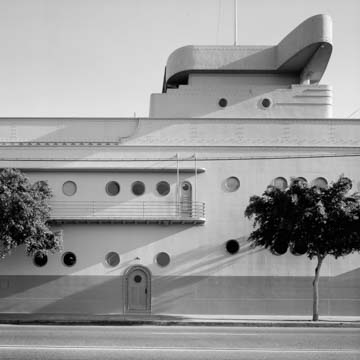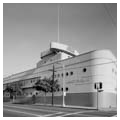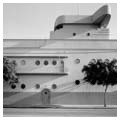There is no logical explanation as to why the Coca-Cola Bottling Plant in central Los Angeles should look like an ocean liner—perhaps the two are similar in scale but the comparisons end there. As unexpected as it is, the Coca-Cola Bottling Plant successfully combines the humor of programmatic architecture with the elegance of the Streamlined Moderne style.
Stanley Barbee, president of the Coca-Cola Company of Southern California, wanted to consolidate the four existing brick office, production, and warehouse buildings at the corner of East 14th Street and South Central Avenue into one unified structure. Barbee hired architect Robert Derrah, who had recently completed Los Angeles’s first outdoor shopping mall, The Crossroads of the World (1936), to consolidate the buildings and create a new unifying facade in what continues to be an industrial neighborhood. Barbee and Derrah approached the project with the humor specific to Los Angeles and Hollywood, the same humor that prompted the Samson Tire and Rubber Company to build an enormous Assyrian-style citadel to house its Los Angeles factory seven years prior. The Coca-Cola Bottling Plant plainly defies its nautical referent in that its sides come together at a ninety-degree angle on the street corner.
Derrah used reinforced concrete for the new facade, with simulated rivets around the curved entryways and double rows of porthole windows that mimic an ocean liner. The flat roof is ornamented with a metal catwalk and railings: a Coca-Cola sign is expertly placed on the landlocked ship’s bridge. The entire 150 x 200–foot, 4-story-high ship is painted nautical white, with a street-level waterline band of black and an elegant narrow horizontal band of red a yard higher. The building’s nautical theme is continued inside with lavish details such as mahogany flooring and handrails. Actual ship ventilators, brass ladders and fittings, as well as steel ship doors that lead to offices complete the Hollywood-style simulacrum.
The Coca-Cola Bottling Plant is not open to the public but is clearly visible from the street. It was designated a Los Angeles Historic-Cultural Monument in 1975.
References
Gebhard, David, and Harriette Von Breton. L.A. in the Thirties, 1931-1941. Layton, UT: Peregrine Smith, 1975.
Heimann, Jim. California Crazy: American Pop Architecture. Köln: Taschen, 2018.























